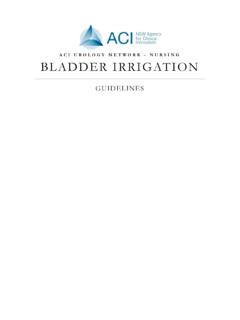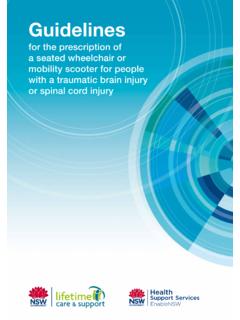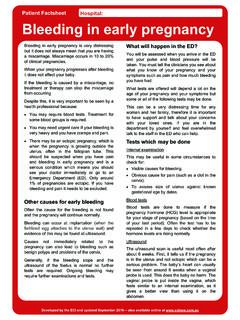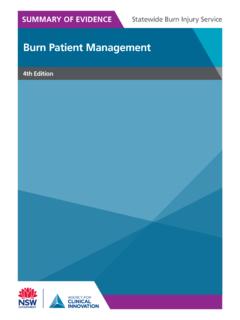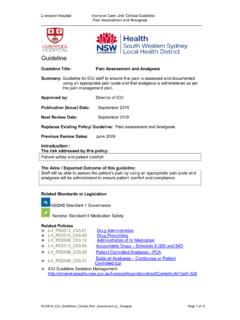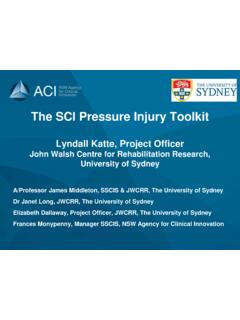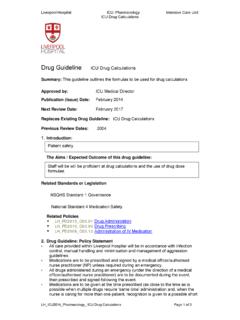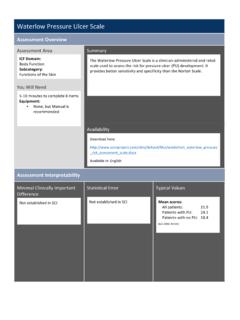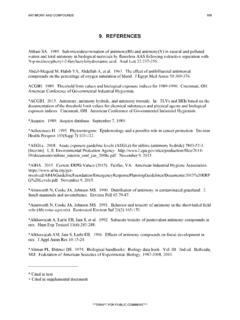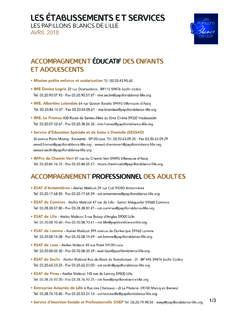Transcription of ACI UROLOGY NETWORK NURSING- NURSING …
1 NURSING MANAGEMENT OF PATIENTS WITH NEPHROSTOMY TUBES GUIDELINES AND PATIENT INFORMATION TEMPLATES ACI UROLOGY NETWORK - NURSING 2 The following pages provide a clinical guideline template to enable clinicians to develop their own resource material relevant to their hospital and Area Health Service. They have been compiled by clinicians for clinicians. If you wish to use this material please acknowledge those that have kindly provided their work to enable use by others. Revise all material with colleagues before using to ensure it is current and reflects best practice. Disclaimer: The information contained herein is provided in good faith as a public service. The accuracy of any statements made is not guaranteed and it is the responsibility of readers to make their own enquiries as to the accuracy, currency and appropriateness of any information or advice provided.
2 Liability for any act or omission occurring in reliance on this document or for any loss, damage or injury occurring as a consequence of such act or omission is expressly disclaimed. With thanks to Liverpool Health Service SSWAHS, Selvi Naidu, Virginia IP, Colleen McDonald and the ACI (Previously GMCT) UROLOGY NURSING Education Working Party Members. Original policy developed Maria Almeida (CNE), Ninia Padilla (RN). Adapted by ACI Sept 2008. Revised May 2012 3 NURSING MANAGEMENT OF PATIENTS WITH NEPHROSTOMY TUBE GUIDELINES AND PATIENT INFORMATION TEMPLATES CONTENTS CONTENTS .. 3 EXPECTED 5 Acute care setting .. 5 General: Acute/Community .. 5 BACKGROUND .. 6 TYPES OF NEPHROSTOMY DRAINAGE TUBES .. 6 INDICATIONS FOR INSERTION OF A NEPHROSTOMY TUBE .. 6 INSERTION OF A NEPHROSTOMY TUBE .. 7 Pre- Procedure Management .. 7 Post-Procedure Management .. 7 ONGOING CARE .. 8 Irrigation of Nephrostomy Tube .. 8 Important Points to Consider .. 8 Equipment.
3 9 NEPHROSTOMY TUBE REMOVA L .. 10 equipment .. 10 Procedure .. 10 Pigtail .. 11 Wide bore catheter (Foley type) .. 11 Malecot Catheter (not commonly used) .. 11 ACI UROLOGY NETWORK - NURSING 4 PATIENT DISCHARGE .. 12 FUNDING SCHEMES FOR PRODUCTS .. 12 Australian Government funded Schemes .. 12 Continence Aids Payment Scheme (CAPS) .. 12 Depa rtm ent of Vetera ns Affa irs ( DVA) .. 13 Funding Schemes by State Government in New South Wales 14 E N AB L E .. 14 provides a subsidy towards the cost of equipment covering disposable and re-usable continence aids for people living in the community who : .. 14 REFERENCES .. 15 PATIENT FACT SHEET .. 16 With thanks to Liverpool Health Service SSWAHS, Selvi Naidu, Virginia IP, Colleen McDonald and the ACI (Previously GMCT) UROLOGY NURSING Education Working Party Members. Original policy developed Maria Almeida (CNE), Ninia Padilla (RN). Adapted by ACI Sept 2008. Revised May 2012 5 EXPECTED OUTCOME The nephrostomy tube is inserted directly into the collecting system of the kidney to allow permanent or temporary urinary drainage.
4 The following applies to all patients undergoing insertion or change of a nephrostomy tube. ACUTE CARE SETTING Written patient consent must be obtained prior to insertion or change of the tube. A fluid balance chart must be maintained for all patients whilst a nephrostomy tube is insitu. A Medical Officer must document the order for irrigation and stipulate the amount of normal saline to be used Medical Officer must document the order for removal of a nephrostomy tube. Removal of the nephrostomy tube must be attended by a Medical Officer or a Registered Nurse experienced in the procedure and with a Medical Officer s written order ( in line with local policy) All nephrostomy tubes must be checked once per shift for patency and abnormal signs or symptoms ( pain, leakage or bleeding) or as required in an acute care setting. Urea, electrolytes and creatinine (UEC s), must be ordered and monitored by Medical Officer All patients and their families/carers must be educated in care of nephrostomy tube well in advance of discharge and provided with a nephrostomy fact sheet and contact telephone numbers in case of problems.
5 Patient to be referred to Community Health NURSING for continuity of care GENERAL: ACUTE/COMMUNITY A Medical Officer must order irrigation of nephrostomy tube A Medical Officer (MO) or a Registered Nurse (RN) experienced in the procedure must perform irrigation of the nephrostomy tube ( in line with local policy) A Medical Officer must document the order for irrigation and stipulate the amount of normal saline to be used Medical Officer must document the order for removal of a nephrostomy tube. 6 Sterile technique must be maintained for irrigation, dressing changes and when obtaining urine specimen. All urine specimens must be collected from nephrostomy tube by gravity. Do not use aspiration. Nephrostomy tubes must be firmly secured and drainage bag anchored to prevent displacement or kinking of the tube. All patients discharged with a nephrostomy tube must be referred to the Community Nurse to ensure that client/carer is monitoring patency of tube and for maintenance of continuity of care BACKGROUND Percutaneous Nephrostomy is an image-guided placement of a catheter into the renal collecting system.
6 Nephrostomy tubes are inserted in the Operating Theatre or Radiology Department to provide permanent or temporary urinary drainage following a procedure or to relieve ureteric obstruction. Irrigation of a nephrostomy tube is indicated if there is absence of urine in the drainage system, blood in the urine or if flank pain occurs. Medical Officer orders irrigation of the nephrostomy tube TYPES OF NEPHROSTOMY DRAINAGE TUBES Pigtail: The retaining mechanism is a coil which is retained within the renal pelvis (placed in Radiology). There are 2 types of pigtail catheters on the market Cook Mac-loc and the Boston Scientific. The only difference is the method of unlocking the catheter for removal. Wide Bore Malecot or foley catheter (placed in operating theatre) INDICATIONS FOR INSERTION OF A NEPHROSTOMY TUBE To remove renal calculi. To decompress an obstructed system and to maintain or improve renal function following ureteric obstruction To obtain access to the renal pelvis for radiological procedures.
7 Insertion of ante grade stent With thanks to Liverpool Health Service SSWAHS, Selvi Naidu, Virginia IP, Colleen McDonald and the ACI (Previously GMCT) UROLOGY NURSING Education Working Party Members. Original policy developed Maria Almeida (CNE), Ninia Padilla (RN). Adapted by ACI Sept 2008. Revised May 2012 7 INSERTION OF A NEPHROSTOMY TUBE PRE- PROCEDURE MANAGEMENT Nil by mouth six hours prior to the procedure or as ordered by Medical Officer. Confirm with Medical Officer the administration or withholding of anticoagulants and other medication Administer analgesia or pre-medication as prescribed. Non-insulin dependent diabetic patients must have blood glucose levels (BSL) checked according to facility protocol from fasting time. Insulin dependent diabetic patients must have insulin dextrose infusion and hourly BSL checked unless otherwise stated by Medical Officer. UECs must be obtained pre-procedure and results to be reviewed by Medical Officer.
8 POST-PROCEDURE MANAGEMENT Administer analgesia as prescribed. Patient should be on bed rest for 4 hours Nephrostomy tube must be connected to a sterile closed drainage system and drainage bag should be below level of kidney at all times. Post procedure vital signs to be monitored half hourly for 2 hours, hourly for the next 2 hours then four hourly for 24 hours. If temperature is higher than 38 degrees, systolic blood pressure less than 100mmhg and/or pulse greater than 120 beats per minute, Medical Officer must be notified. If Medical Emergency Team criteria exist, call the team Measure urine output hourly for 4 hours, then 4 hourly for 24 hours then progress to 8 hourly until stable. If total urine output is less than 30mls/hr notify Medical Officer. Monitor urine for colour and presence of sediment. 8 Note: It is normal for blood to be present in the urine immediately after nephrostomy insertion but it should decrease within 48 hours.
9 Notify Medical Officer if urine flow consistently remains heavily blood stained. Strict fluid balance chart must be maintained Medical Officer must monitor UEC s until results are stabilized. Nephrostomy tube dressing site must be observed every hour for four hours, 4 hourly for 24 hours, then once per shift for bleeding and signs of infection (pain, leakage, redness, swelling, bleeding) Report any abnormalities to the Medical Officer. Inspect nephrostomy tube to ensure it is secure and no kinking has occurred Encourage the patient to drink at least two litres of fluid daily unless contraindicated. Observe for leakage at connection joints and seek advice if leakage evident. All urine specimens must be collected from nephrostomy tube by gravity. Do not use aspiration. Nephrostomy tube must be well secured at all times to prevent dislodgment ONGOING CARE IRRIGATION OF NEPHROSTOMY TUBE IMPORTANT POINTS TO CONSIDER This is a sterile procedure Irrigation of the nephrostomy tube is required if there is absence of urine, if urine remains heavily blood stained, if patient has persistent flank pain or suspected blockage.
10 Check with attending Medical Officer if standing orders apply. Do not flush greater than 10 mls of sterile normal saline. Observe for continuous urine flow and signs of infection. Notify Medical Officer immediately if the tube cannot be irrigated or if it is dislodged or fallen out. In a community setting refer the patient to the Emergency department. With thanks to Liverpool Health Service SSWAHS, Selvi Naidu, Virginia IP, Colleen McDonald and the ACI (Previously GMCT) UROLOGY NURSING Education Working Party Members. Original policy developed Maria Almeida (CNE), Ninia Padilla (RN). Adapted by ACI Sept 2008. Revised May 2012 9 EQUIPMENT Personal Protective Equipment (PPE) Dressing pack Disposable blue sheet Sterile gloves Alcohol wipes or 70% alcohol 10 ml syringe for Pigtail Catheter) Catheter tip Toomey syringe for Foley Catheter) Sterile normal saline Drainfix dressing PROCEDURE Confirm the order is documented by the Medical Officer in the patient s health care record.

